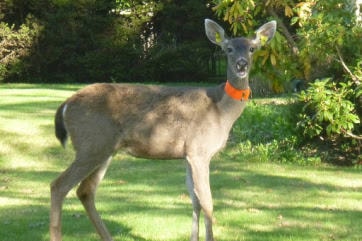What a successful autumn it’s been!
Prior to September’s field work, Dr. Jason Fisher continued to lead the research on deer populations, densities, space use, habitat selection, distribution and movement patterns.
This research is an incredibly important component of the multi-year project, giving Oak Bay and other communities information on urban Columbian Black-tailed deer ecology that is helping wildlife biologists, the province and other communities understand more about the indigenous urban deer populations in our midst.
It’s important to remember that while few of us saw deer in urban settings as recently as 10 years ago, they have been on this land for thousands of years, as indicated in First Nations historical records.
To that point, the UWSS is proud to have received the endorsement of the Songhees Nation for IC as the best management tool for the indigenous black-tailed deer population.
A first set of data, collected from 20 does with GPS collars and 39 motion sensitive cameras was analyzed last winter (see preliminary report here).
An expanded dataset will be analyzed this winter and after fawning season ends next summer. The next set of data will help the wildlife scientists better understand the fawning rate and population structure (e.g. ratio of bucks, does, and fawns in the population).
While the important research continued, the next step was to actually provide IC to does this fall, with the number of does determined based on the initial dataset. Although scientists had a permit to IC up to 80 does, they knew from the preliminary report that that would be the high-end of the number of does, particularly as a control group of 20 does do not receive IC. Still, scientists were prepared to treat as many as they could in the short window available for IC field work.
So what did IC actually involve?
Between early September and the end of October, wildlife veterinarian Dr. Adam Hering, along with Dr. Jason Fisher and his team of grad students, other wildlife biologists, students and community members from Oak Bay and beyond, sedated and then administered an immuno-contraceptive to 60 does.
While the does were sedated and their vital signs carefully monitored, the field teams took blood and fur samples which were sent to the province for analysis. The does were then collared and ear-tagged with colour codes for individual identification before the sedation was reversed. Beginning in mid-September and right through to the end of October, all but three of those 60 does received a booster shot that increases the efficacy of the vaccine to between 85 – 95%.
This means that next spring, scientists expect that only the does that did not receive a vaccine (as there were some) and the control group will give birth to fawns. The post IC data collection will give scientists important information, but it’s likely that there could be a reduction in the fawning rate by approximately 60 to 90 fawns (the younger ones would only have given birth to one fawn, and those that have reached their 4th birthday would likely have had twins).
Of the 60 does, eight were fitted with a prototype GPS collar that is being tested for Margo Supplies, an Alberta company that works to provide proven solutions to wildlife management challenges. Margo Supplies has worked with both Dr. Fisher and Dr. Hering in the past, and the UWSS is delighted to have the opportunity to trial these lightweight and innovative collars — another example of how so many stakeholders have come together to develop and implement a scientifically-based urban deer non-lethal deer management strategy.
As of Oct. 31, this first year of IC came to a close. This is because there is a small window of time that it’s possible to vaccinate does – after fawning season and the summer, but before rutting season begins, usually at the end of October. The provincial permit therefore expired on Oct. 31, and a new one will be applied for before the next round of field work.
Rutting season has now begun
Rutting season is a good opportunity to remind everyone to give bucks lots of space over the next month – please go to the UWSS website for information on how to reduce human-deer conflict.
The urban deer project in Oak Bay is funded by the municipality, the Province of B.C., and through the volunteer work of the UWSS. It’s a research initiative, with the key focus continuing to be the collection and analysis of data that continually informs next steps. The community engagement has been overwhelming, with over 650 home-owners allowing field work to occur on their property, and citizen scientists helping locate deer for vaccinations and boostering.
The work of the UWSS as part of the unique three-way partnership (four including the community!) is being widely recognized as a positive and hopeful approach to managing urban deer. Continuing with this cutting edge and innovative research project led by Dr. Fisher will be key to ensuring its success, and will benefit not just Oak Bay, but also other communities across the CRD, BC and Canada, that are struggling with managing urban deer populations.
